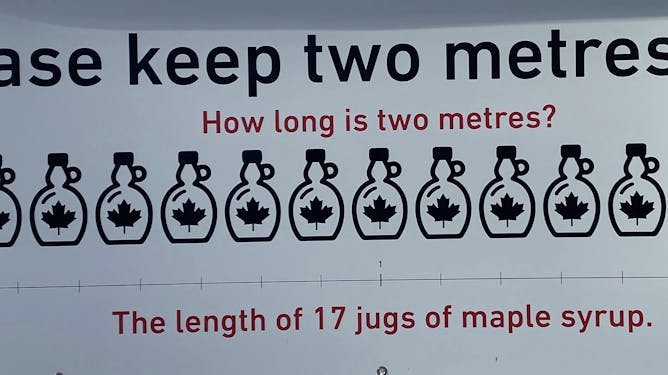|
Has your capacity to eyeball the distance of six feet, two metres or one hockey stick sharpened since the pandemic started due to social distancing signs? If you think so, perhaps like me, you’ll need to break out the measuring tape. Today in The Conversation Canada, Egan J. Chernoff of the University of Saskatchewan, professor of mathematics education, takes issue with common social distancing signs in Canada.
He highlights a problem with flagrant disregard of the metric system, which Canada embraced between 1970 and the mid 1980s. But what’s really got his number is “flippant, dismissive conversion from the imperial to the metric system of measurement.” If you think this is of zero concern, he’ll point you to the social and democratic consequences of lacking a basic grasp of math.
He writes: “During these trying times, we should not be fostering innumeracy.”
Also today:
|

Keeping a safe distance from each other isn’t made simpler when units of measurement are being butchered.
(Egan J. Chernoff)
Egan J Chernoff, University of Saskatchewan
Why haven’t people gotten upset about how our social distancing signs are fostering innumeracy?
|

The holidays can be a time of distress for people who have experienced family trauma.
(Shutterstock)
Heather B MacIntosh, McGill University
Last year’s COVID-19 restrictions were a relief to some people who have experienced family trauma because it spared them difficult holiday visits with relatives. Now, it’s back to holidays as usual.
|

Face scanning technologies are more everyday than we might think.
(Shutterstock)
Stephen Monteiro, Concordia University
Facial recognition technologies have become more popular through increasingly sophisticated devices and popular fads. Casual use of face scanning and analysis features has long-term social impacts.
|

Supporters of Philippine President Rodrigo Duterte and Senator Bong Go shout slogans outside the Commission on Elections in Manila, Philippines, on Nov. 15, 2021.
(AP Photo/Aaron Favila)
Yvonne Su, York University, Canada
Research suggests that communities need jobs, food and health care, not political acts that hijack the spirit of bayanihan.
|

With the holiday season approaching, people wait to receive a COVID-19 vaccination in Montréal as the pandemic continues in Canada and around the world.
THE CANADIAN PRESS/Graham Hughes
Scott White, The Conversation
A panel of experts answer questions about vaccines and other COVID-related issues in a discussion with The Conversation.
|

Le visionnement en rafale, appelé «binge watching» est associé à un comportement de dépendance.
Shutterstock
Mark Griffiths, Nottingham Trent University
Le « binge-watching » peut devenir problématique. Il est associé à l’anxiété et à la dépression.
|
Politics
|
-
Sung-Yoon Lee, Tufts University
Kim Jong Un has followed his father and grandfather in ruling by fear. The coronavirus pandemic has made North Korea ever more isolated, while expanded military capabilities make it a growing threat.
|
|
Arts
|
-
Marieke Norton, University of Cape Town
Woven throughout the backstories of these characters is the loss of loved ones, lack of resources and the desperation to get out of economic hardship.
|
|
Business + Economy
|
-
Gabriella Legrenzi, Keele University; Reinhold Heinlein, University of the West of England; Scott Mahadeo, University of Portsmouth
A surge in stock markets towards year end goes against the idea of rational traders, yet it often happens.
|
|